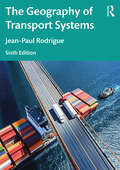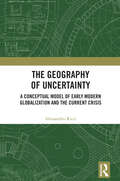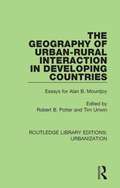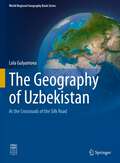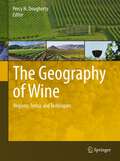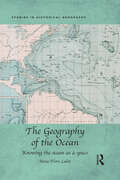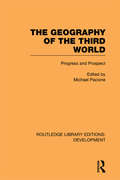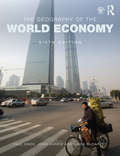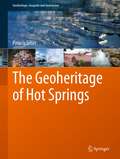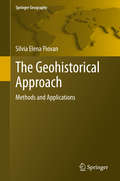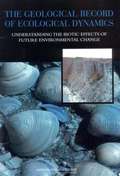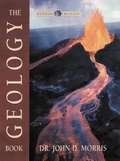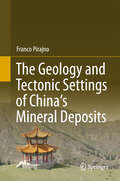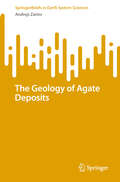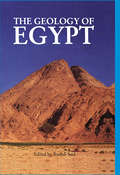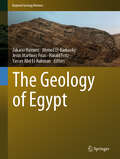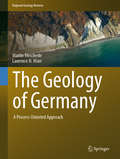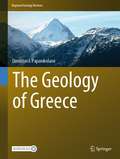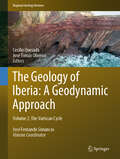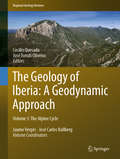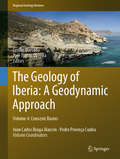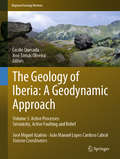- Table View
- List View
The Geography of Transport Systems
by Jean-Paul RodrigueThis expanded and revised sixth edition of The Geography of Transport Systems provides a comprehensive and accessible introduction to the field with a broad overview of its concepts, methods, and areas of application. It explores the spatial aspects of transportation and focuses on how the mobility of passengers and freight is linked with geography.The book is divided into ten chapters, each covering a specific conceptual dimension, including networks, modes, terminals, freight transportation, urban transportation, and environmental impacts, and updated with the latest information available. The sixth edition offers new and updated material on information technologies and mobility, e-commerce, transport and the economy, mobility and society, supply chains, security, pandemics, energy and the environment, and climate change. With over 140 updated figures and maps, The Geography of Transport Systems presents transportation systems at different scales ranging from global to local.This volume is an essential resource for undergraduates studying transportation, as well as those interested in economic and urban geography, transport planning and engineering. A companion website, which contains additional material such as photographs, maps, figures, and PowerPoint presentations, has been developed for the book and can be found here: https://transportgeography.org/
The Geography of Uncertainty: A Conceptual Model of Early Modern Globalization and the Current Crisis
by Alessandro RicciThis book outlines the characteristics and implications of a potential geography of uncertainty. In doing so, it analyses this concept in reference to both the origins of uncertainty in Early Modern Age and the current geopolitical situation. The book adopts an interdisciplinary approach to uncertainty, drawing on global perspectives and literature to define its meanings and characteristics. In order to develop a thorough and precise understanding of the geography of uncertainty, a broad perspective is adopted, which includes other forms of knowledge in which the concept of uncertainty is firmly established. As such the book creates temporal links, that may occasionally be far off from one another, to present a geographical perspective of uncertainty. It provides an interpretation of the phenomenon of globalization in a new way, relating it to the first European openness to global spaces, the Early Modern Age, and identifying the transition from the medieval world to the Modern Age as the first manifestation of uncertainty in geography. Uncertainty is more prevalent than ever in today's geopolitical, economic, financial and social reality, as well as the ongoing emergencies and crises. The book adopts an interdisciplinary approach rooted in the geography of Early Modernity by referring to geopolitical scenarios, literature and philosophy, to target the historical roots and the prevailing configuration of the geography of uncertainty. It will appeal to scholars and students of human and political geography, politics, philosophy, international relations, economics and history.
The Geography of Urban-Rural Interaction in Developing Countries: Essays for Alan B. Mountjoy (Routledge Library Editions: Urbanization #7)
by Robert B. Potter Tim UnwinOriginally published in 1989, The Geography of Urban-Rural Interaction in Developing Countries addresses the nature and importance of the interaction between ‘urban’ and ‘rural’ areas within Third World national territories, providing much-needed comparative, cross-cultural, and cross-national material. The book discusses the various theories of urban-rural interaction, and summarises the topic in the form of the movement of people, goods, money, capital, new technology, energy, information and ideas. Case studies are drawn from different areas of the Third World – including Africa, Asia, the Middle East, and the Caribbean and illustrate in detail the nature of urban-rural interaction.
The Geography of Uzbekistan: At the Crossroads of the Silk Road (World Regional Geography Book Series)
by Lola GulyamovaThis book describes the geography of Uzbekistan and its unique history and culture. It focuses on the development of Uzbekistan as a result of its location on the crossroads of the Silk Road. The influence of global and regional environmental challenges on the current landscape and similar issues are discussed and analyzed from a historical perspective. Contemporary tensions and reforms in social, economical and cultural life are described with the aim to draw a picture of modern paths to transformation and development. The Geography of Uzbekistan includes also information on geology, nature and natural resources, in particular water. The book discusses the social and environmental impacts of the Aral Sea disaster and shows new paths of transformation and development for this Central Asian country.
The Geography of Wine
by Percy H. DoughertyWine has been described as a window into places, cultures and times. Geographers have studied wine since the time of the early Greeks and Romans, when viticulturalists realized that the same grape grown in different geographic regions produced wine with differing olfactory and taste characteristics. This book, based on research presented to the Wine Specialty Group of the Association of American Geographers, shows just how far the relationship has come since the time of Bacchus and Dionysus. Geographers have technical input into the wine industry, with exciting new research tackling subjects such as the impact of climate change on grape production, to the use of remote sensing and Geographical Information Systems for improving the quality of crops. This book explores the interdisciplinary connections and science behind world viticulture. Chapters cover a wide range of topics from the way in which landforms and soil affect wine production, to the climatic aberration of the Niagara wine industry, to the social and structural challenges in reshaping the South African wine industry after the fall of apartheid. The fundamentals are detailed too, with a comparative analysis of Bordeaux and Burgundy, and chapters on the geography of wine and the meaning of the term 'terroir'.
The Geography of the Ocean: Knowing the ocean as a space (Studies in Historical Geography)
by Anne-Flore LaloëDespite the fact that the vast majority of the earth’s surface is made up of oceans, there has been surprisingly little work by geographers which critically examines the ocean-space and our knowledge and perceptions of it. This book employs a broad conceptual and methodological framework to analyse specific events that have contributed to the production of geographical knowledge about the ocean. These include, but are not limited to, Christopher Columbus’ first transatlantic journey, the mapping of nonexistent islands, the establishment of transoceanic trade routes, the discovery of largescale water movements, the HMS Challenger expedition, the search for the elusive Terra Australis Incognita, the formulation of the theory of continental drift and the mapping of the seabed. Using a combination of original, empirical (archival, material and cartographic), and theoretical sources, this book uniquely brings together fascinating narratives throughout history to produce a representation and mapping of geographical oceanic knowledge. It questions how we know what we know about the oceans and how this knowledge is represented and mapped. The book then uses this representation and mapping as a way to coherently trace the evolution of oceanic spatial awareness. In recent years, particularly in historical geography, discovering and knowing the ocean-space has been a completely separate enterprise from discovering and colonising the lands beyond it. There has been such focus on studying colonised lands, yet the oceans between them have been neglected. This book gives the geographical ocean a voice to be acknowledged as a space where history, geography and indeed historical geography took place.
The Geography of the Third World: Progress and Prospect (Routledge Library Editions: Development)
by Michael PacioneFirst published in 1988, this reissue presents a comprehensive overview of contemporary developments and research into the geography of the Third World, at a time when economies and societies there were changing at a much more rapid rate than their counterparts in the developing world. It covers the topic both systematically and by region, showing how the unique background of each region affects developments there.
The Geography of the World Economy: An Introduction To Economics Geography
by Linda Mccarthy Paul Knox John A AgnewThe Geography of the World Economy provides an in-depth and stimulating introduction to the globalization of the world economy. The book offers a consideration of local, regional, national and global economic development over the long historical term. The theory and practice of economic and political geography provide a basis for understanding the interactions within and among the developed and developing countries of the world. Illustrated in color throughout, this new edition has been completely reworked and updated to take account of recent significant changes in the world economy. A new companion website also accompanies the book, with additional resources for each chapter including multiple choice and short essay questions and links to relevant websites. Figures and tables are also available for download located at www.routledge.com/cw/knox The text is signposted throughout with an glossary of key terms, and is richly illustrated with full-color maps, diagrams and illustrations. It is ideal for upper level university undergraduates and for post-graduates in a variety of specializations including geography, economics, political science, international relations and global studies.
The Geoheritage of Hot Springs (Geoheritage, Geoparks and Geotourism)
by Patricia ErfurtThe aim of this book is to provide an overview of topics related to the extensive geoheritage of hot springs, their natural environments, and their integration into commercial and industrial functions. The eleven chapters explore aspects of historical and cultural traditions, geology and geochemistry, research updates, conservation issues and of course health, wellness, and recreation throughout time. Because natural hot springs and active hydrothermal areas play a significant role in the tourism industry, visitor expectations are examined together with an assessment of common hazards and potential risks in active hydrothermal environments, along with recommendations how to stay safe.For the purpose of showcasing certain unique features, to share noteworthy events and developments or to identify concerns associated with the sustainability of natural water source, examples of particular hot spring areas are included in several chapters. One chapter is also dedicated entirely to the protection of natural hot springs and raises awareness for conservation, while another chapter reviews the history of hot springs in great detail to establish a realistic and justifiable timeline of their original use. Lastly, the significance of natural hot springs for various tourism sectors is analysed and the potential for sustainable future destination development in rural and remote regions is discussed.Many locations were considered and invite the reader to use the information as a reference point in the quest to further explore the remarkable natural and cultural geoheritage of hot springs worldwide.
The Geohistorical Approach: Methods and Applications (Springer Geography)
by Silvia Elena PiovanThis book gives a comprehensive view of the strengths and limits of the interdisciplinary methods that work together to form the geohistorical approach to geographical and geological sciences. The geohistorical approach can be synthetically defined as a multi- and interdisciplinary approach that uses techniques and perspectives, mainly from geography, history, and natural sciences, to examine topics that inform the space-time knowledge of environment, territory, and landscape. The boundary between the application of physical and human science methods is large and hazy. This volume exists at this boundary and offers an approach that utilizes both historical data (from both physical and human records) and GIScience (e.g. GIS, cartography, GPS, remote sensing) to investigate the evolution of the environment, territory and landscape through both space and time. The first objective of this volume is to define the term geohistorical approach. An entire chapter focuses on a review of the main disciplines that connect geography and history, a review of the terms environment, territory, and landscape as objects of study of this approach, and the definition and importance of the geohistorical approach. The second goal is to describe the methods used in the geohistorical approach. Eight chapters present the key methods also using examples of applications from the international context, offering an awareness of the potentials, limitations and accuracy of each method, with particular focus on the integration of methods. The third goal is to provide case studies to demonstrate the use and integration of geohistorical methods from both original material and published research. A final chapter is dedicated to an interdisciplinary case study from the Venetian Plain (Italy), providing an example of the integration of almost all methods described in the book.
The Geological Record Of Ecological Dynamics: Understanding The Biotic Effects Of Future Environmental Change
by National Research Council of the National AcademiesIn order to answer important questions about ecosystems and biodiversity, scientists can look to the past geological record—which includes fossils, sediment and ice cores, and tree rings. Because of recent advances in earth scientists’ ability to analyze biological and environmental information from geological data, the National Science Foundation and the U.S. Geological Survey asked a National Research Council (NRC) committee to assess the scientific opportunities provided by the geologic record and recommend how scientists can take advantage of these opportunities for the nation’s benefit. The committee identified three initiatives for future research to be developed over the next decade: (1) use the geological record as a “natural laboratory” to explore changes in living things under a range of past conditions, (2) use the record to better predict the response of biological systems to climate change, and (3) use geologic information to evaluate the effects of human and non-human factors on ecosystems. The committee also offered suggestions for improving the field through better training, improved databases, and additional funding.
The Geology Book
by John D. MorrisThe Geology Book explores the physical features of the planet from core to crust, explaining earthquakes, volcanoes, geysers, rock layers, and the age of the earth.
The Geology Companion: Essentials for Understanding the Earth
by Gary Prost Benjamin ProstThis practical guidebook provides a basic grounding in the principles of geology and explains how to apply them. Using this book, readers will be able to figure out whether they are standing on an ancient seafloor, coal swamp, or sand dune. They will be able to determine the geologic hazards in their neighborhood, where to look for fossils and minerals, or where best to drill a water well. In plain English, The Geology Companion sheds light on the processes that shape the earth and how geology affects people in their daily lives.
The Geology and Tectonic Settings of China's Mineral Deposits
by Franco PirajnoExtensive descriptions of a wide range of key or world-class mineral deposits of China are presented in the context of the country's general geology, tectonic units and mineral systems and their geodynamic evolution within the tectonic framework of the Asian continent. This comprehensive overview, incorporating the latest geological concepts, is the first such coverage written in English by a western expert, and will be of benefit to mineral explorers and miners, as well as to research scientists and students in institutions of higher education. In his compilation of this compendium of Chinese geology and mineral systems, Franco Pirajno draws on first-hand knowledge of China's geology and mineral deposits gained in numerous field visits and research projects with Chinese colleagues from various academic institutions over the past 18 years. First time that a western-based book on China's geology and mineral deposits is published Appropriate for use by the mineral exploration industry Modern English-language geological and mineral deposits information on China Most useful to Western (and Chinese) geoscientists
The Geology of Agate Deposits (SpringerBriefs in Earth System Sciences)
by Andrejs ZarinsThis book examines agate provinces through the lens of plate tectonics, stratigraphy, agatization, and more. It delves into the physical and chemical properties of agate deposits, their environments of formation, and related silica deposits like opal, chert, and petrified wood. Examples, illustrations, maps, and thin-section photos illuminate structural, chemical, and temporal controls. Plate tectonics and lithotectonics are explored to provide a deeper understanding of the volcanic processes behind agate formation.
The Geology of Australia
by David JohnsonThe Geology of Australia provides a vivid and informative account of the evolution of the Australian continent over the last 4400 million years. Starting with the Precambrian rocks that hold clues to the origins of life and the development of an oxygenated atmosphere, it goes on to cover the warm seas, volcanism and episodes of mountain building, which formed the eastern third of the Australian continent. This illuminating history details the breakup of the supercontinents Rodinia and Gondwana, the times of previous glaciations, the development of climates and landscapes in modern Australia, and the creation of the continental shelves and coastlines. Separate chapters cover the origin of the Great Barrier Reef, the basalts in Eastern Australia, and the geology of the Solar System. This second edition features two new chapters, covering the evolution of life on Earth while emphasising the fossil record in Australia, and providing a geological perspective on climate change. From Uluru to the Great Dividing Range, from earthquakes to dinosaurs, from sapphires to the stars The Geology of Australia is a comprehensive exploration of the timeless forces that have shaped this continent.
The Geology of Australia
by David Johnson Robert HendersonThe Geology of Australia provides a vivid and informative account of the evolution of the Australian continent over the last 4400 million years. Starting with the Precambrian rocks that hold clues to the origins of life and the development of an oxygenated atmosphere, it goes on to cover the warm seas, volcanism and episodes of mountain building, which formed the eastern third of the Australian continent. This illuminating history details the breakup of the supercontinents Rodinia and Gondwana, the times of previous glaciations, the development of climates and landscapes in modern Australia, and the creation of the continental shelves and coastlines. Separate chapters cover the origin of the Great Barrier Reef, the basalts in Eastern Australia, and the geology of the Solar System. This second edition features two new chapters, covering the evolution of life on Earth while emphasising the fossil record in Australia, and providing a geological perspective on climate change. From Uluru to the Great Dividing Range, from earthquakes to dinosaurs, from sapphires to the stars The Geology of Australia is a comprehensive exploration of the timeless forces that have shaped this continent.
The Geology of Egypt
by Rushdi SaidScholars from Egypt, Germany and the US review and analyze the results of work carried out on the geology of Egypt: geomorphology and evolution of landscape, tectonics, geophysical regime, volcanicity, Precambrian geology, geologic history and paleogeography, paleontology of selected taxa, ore depos
The Geology of Egypt (Regional Geology Reviews)
by Jesús Martínez Frías Zakaria Hamimi Ahmed El-Barkooky Harald Fritz Yasser Abd El-RahmanThis richly illustrated book offers a concise overview of the geology of Egypt in the context of the geology of the Arab Region and Northeast Africa. An introductory chapter on history of geological research in Egypt sheds much light on the stages before and after the establishment of Egyptian Geological Survey (the second oldest geological survey worldwide), Hume's book and Said's 1962, 1990 books. The book starts with the Precambrian geology of Egypt, in terms of lithostratigraphy and classifications, structural and tectonic framework, crustal evolution and metamorphic belts. A dedicated chapter discusses the Paleozoic-Mesozoic-Cenozoic tectonics and structural evolution of Egypt. A chapter highlights the Red Sea tectonics and the Gulf of Suez and Gulf of Aqaba Rifts. Subsequent chapters address the Phanerozoic geology from Paleozoic to Quaternary. The Egyptian Impact Crater(s) and Meteorites are dealt with in a separate chapter. The Earth resources in Egypt, including metallic and non-metallic ore deposits, hydrocarbon and water resources, are given much more attention throughout four chapters. The last chapter addresses the seismicity, seismotectonics and neotectonics of Egypt.
The Geology of Germany: A Process-Oriented Approach (Regional Geology Reviews)
by Martin Meschede Laurence N. WarrThis richly illustrated book presents Germany’s geological evolution in the context of the Earth’s dynamic history. It starts with an introduction to Geology and explains the plate tectonic development, as well as the formation of both ancient and recent mountain belts – namely the Caledonian, Variscan and the modern-day Alps – that formed this part of Europe. A dedicated chapter discusses the origin of earthquakes in Germany, the occurrence of young volcanic rocks and the various episodes of rock deformation and metamorphism at these complex crossroads of plate tectonic history. The book highlights Germany’s diverse geological history, ranging from the origin of the Earth, the formation of deep crystalline rocks, and their overlying sedimentary sequences, to its more recent “ice age” quaternary cover. The last chapter addresses the shaping of the modern landscape. Though the content is also accessible for non-geologists, it is primarily intended for geoscience students and an academic audience.
The Geology of Greece (Regional Geology Reviews)
by Dimitrios I. PapanikolaouThis book introduces the reader to the unique geology of Greece. This country is a natural geology laboratory that can help us understand the present-day active geodynamic processes in the Hellenic orogenic arc, including earthquakes, volcanoes, coastline changes and other processes of uplift and subsidence, as well as the intense erosion, transport and deposition of sediments. Additionally, Greece offers a remarkable geological museum, reflecting the complex history of the area over the last 300 million years. By studying the rocks of Greece, one can discover old oceanic basins, e.g. in the Northern Pindos and Othrys mountains, crystalline rocks of Palaeozoic age, old granitic and volcanic rocks, as well as other sedimentary rocks including fossils from the shallow neritic facies to pelagic and abyssal facies. The younger sediments demonstrate the continuously changing palaeogeography of Greece, with areas of lakes, high plateaus and gulfs that are transformed into new forms of islands, peninsulas or high mountains, etc. All the above subjects are included in the book, which describes the tectonic structure of the geological strata, together with the evolutionary stages of the palaeogeography and geodynamics within the broader Mediterranean context. A special characteristic of the book is the development of the orogenic model of the Hellenides with the application of the tectono-stratigraphic terrane concept in the Tethyan system.
The Geology of Iberia: Volume 2: The Variscan Cycle (Regional Geology Reviews)
by Cecilio Quesada José Tomás OliveiraTaking a new global approach, this unique book provides an updated review of the geology of Iberia and its continental margins from a geodynamic perspective. Owing to its location close to successive plate margins, Iberia has played a pivotal role in the geodynamic evolution of the Gondwanan, Rheic, Pangea, Tethys s.l. and Eurasian plates over the last 600 Ma of Earth's history. The geological record starts with the amalgamation of Gondwana in the Neoproterozoic succeeded by the rifting and spreading of the Rheic ocean; its demise, which led to the amalgamation of Pangea in the late Paleozoic; the rifting and spreading of several arms of the Neotethys ocean in the Mesozoic Era and their ongoing closure, which was responsible for the Alpine orogeny. The significant advances in the last 20 years have attracted international research interest in the geology of the Iberian Peninsula. This volume presents the most comprehensive, careful and updated description of the variscan cycle in Iberia. This volume focuses in the different geological events since the Cambrian-Early Ordovician rift until the late variscan orocline formations including magmatic and metamorphic evolution.
The Geology of Iberia: Volume 3: The Alpine Cycle (Regional Geology Reviews)
by Cecilio Quesada José Tomás OliveiraTaking a new global approach, this unique book provides an updated review of the geology of Iberia and its continental margins from a geodynamic perspective. Owing to its location close to successive plate margins, Iberia has played a pivotal role in the geodynamic evolution of the Gondwanan, Rheic, Pangea, Tethys s.l. and Eurasian plates over the last 600 Ma of Earth's history. The geological record starts with the amalgamation of Gondwana in the Neoproterozoic succeeded by the rifting and spreading of the Rheic ocean; its demise, which led to the amalgamation of Pangea in the late Paleozoic; the rifting and spreading of several arms of the Neotethys ocean in the Mesozoic Era and their ongoing closure, which was responsible for the Alpine orogeny. The significant advances in the last 20 years have attracted international research interest in the geology of the Iberian Peninsula. This volume presents the most comprehensive, and updated description of the Alpine cycle in Iberia. This volume focuses in the different geological events during the Alpine orogeny as well as the lithological succession . This book is of interest not only for scientists of Portugal and Spain but also for geoscientists searching for analogies for oil and gas as well as tourists visiting the main mountain ridges of Iberia such as the Pyrenees.
The Geology of Iberia: Volume 4: Cenozoic Basins (Regional Geology Reviews)
by Cecilio Quesada José Tomás OliveiraPursuing an innovative, global approach, this unique book provides an updated review of the geology of Iberia and its continental margins from a geodynamic perspective. Owing to its location close to successive plate margins, Iberia has played a pivotal role in the geodynamic evolution of the Gondwanan, Rheic, Pangea, Tethys and Eurasian plates over the last 600 Ma of Earth’s history. The geological record starts with the amalgamation of Gondwana in the Neoproterozoic, which was succeeded by the rifting and spreading of the Rheic ocean; its demise, which led to the amalgamation of Pangea in the late Paleozoic; the rifting and spreading of several arms of the Neotethys ocean in the Mesozoic Era and their ongoing closure, which was responsible for the Alpine orogeny. The significant advances in the last 20 years have increasingly attracted international interest in exploring the geology of the Iberian Peninsula. This volume focuses on the Cenozoic basins of the Iberian Geology and consequently the most recent sedimentary features in the Iberian Geology apart of the active ones. In this book, you will find a detailed explanation of the alpine foreland basins, the extension of the west Mediterranean as well as the latest magmatism in Iberia.
The Geology of Iberia: Volume 5: Active Processes: Seismicity, Active Faulting and Relief (Regional Geology Reviews)
by Cecilio Quesada José Tomás OliveiraAdopting a global approach, this unique book provides an updated review of the geology of Iberia and its continental margins from a geodynamic perspective. Owing to its location close to successive plate margins, Iberia has played a pivotal role in the geodynamic evolution of the Gondwanan, Rheic, Pangea, Tethys and Eurasian plates over the last 600 Ma of Earth’s history. The geological record starts with the amalgamation of Gondwana in the Neoproterozoic, which was succeeded by the rifting and spreading of the Rheic ocean; its demise, which led to the amalgamation of Pangea in the late Paleozoic; and the rifting and spreading of several arms of the Neotethys ocean in the Mesozoic Era and their ongoing closure, which was responsible for the Alpine orogeny. The significant advances in the last 20 years have increasingly attracted international interest in exploring the geology of the Iberian Peninsula. This final volume of the Geology of Iberia focuses on the active geological processes in Iberia including seismicity and active faulting as well as the modern landscapes in the Iberian Peninsula.
